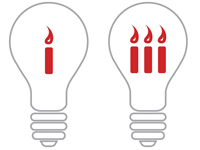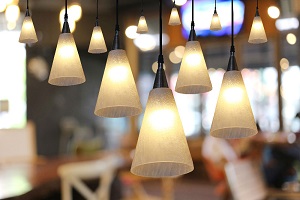
Watts, lumens & LEDs
The simple task of turning on the lights is becoming increasingly complex as the environmental impact of energy waste comes under the spotlight.
Countries all over the world have introduced strict regulations for energy consumption in both residential and commercial properties that specifically target energy waste from lighting. Conversely, regulations about advised brightness levels are also being enforced, ensuring that reduced energy usage doesn’t mean increased health and safety risks due to environments being dimly lit.
The shifting of lighting technologies away from inefficient halogen, compact fluorescent and incandescent bulbs towards long-lasting, eco-friendly LED solutions is also causing confusion as new technologies flood the market. How can accommodation managers ensure their properties are meeting regulations while still choosing the most cost-efficient solution and what key factors should affect lighting choices?
Common terminology: watts versus lumens
It is a common misconception that wattage is the deciding factor when choosing lights. In fact, a bulb’s brightness has nothing to do with its wattage – instead, brightness is measured as lumen output.
A lumen is a unit of measurement for describing how much light a bulb emits. A bulb with a low lumen output will seem dull and will only illuminate a small area, whereas a bulb with a high lumen output will appear bright and illuminate a large area. By contrast, wattage measures electrical power; the amount that we pay for our electricity is dependent on the number of watts that we use.
A truer comparison: efficacy
Wattage and lumen output can be combined to find out a light’s efficacy – a measurement of how efficient the bulb is at turning electrical energy into light – measured in lumens per watts (lm/W).
This is calculated by dividing the lumen output of the light by its wattage. The lumens per watt values of different lights can be compared to find out which product is the most energy efficient, helping to inform lighting decisions where maximum brightness, minimum energy usage and minimum expense are paramount.
Premium 50W halogen light bulbs have an output of roughly 900 lumens, which equates to 18 lumens per watt. In contrast, high-performance 16-watt LED downlights also offer 900 lumens but use as little as 15W of power to give an efficacy of 68 lumens per watt – a much better rating that clearly shows why they are the most cost effective and sustainable choice.
Choosing LED lighting: what to look for
When choosing lighting – whether LED or another technology – don’t compromise on light output. For example if you’re replacing a 50W halogen, don’t settle for anything less than a light output of 720 lumens (the official brightness of 50W halogen according to the Department of Climate and Energy Efficiency).
The efficacy, measured as a lumens per watt rating, should be your second priority. Some lighting packaging now displays this alongside wattage but not all. There are major variations in the quality of LEDs on the market and in many cases the efficacy of an LED light can vary by as much as 30-80 lumens per watt, depending on the brand and quality.
Be especially wary of brands that don’t even tell you their products’ lumen outputs as they are likely to be low-performance.
Check that your lighting manufacturer supports cradle-to-cradle manufacturing cycles, ensuring that the materials that go into their goods can be recycled and used in future lighting products.
Some brands offer a buy-back scheme, which means customers will be rewarded for returning expired products at the end of their lifetimes.
Look for as long a product lifetime as possible but one that’s backed up by proper testing. The IES-LM-80 testing standard is key for products that claim to have exceptionally long lifetimes. As an extra security measure, make sure that the lights you invest in come with a warranty.

AccomNews is not affiliated with any government agency, body or political party. We are an independently owned, family-operated magazine.




